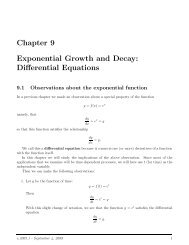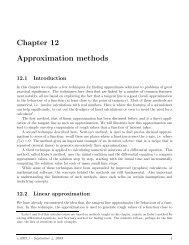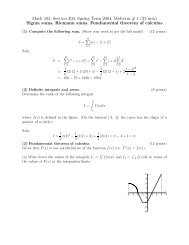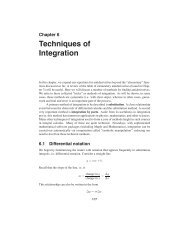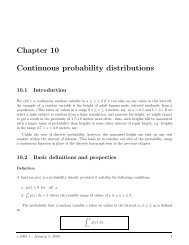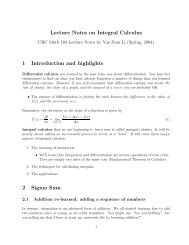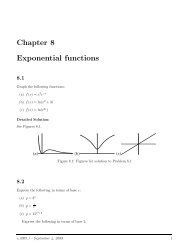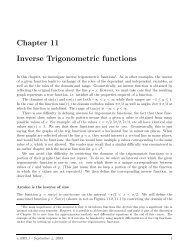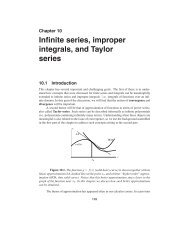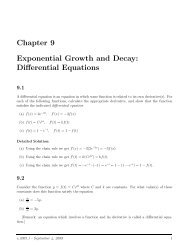Chapter 10 Trigonometric functions - Ugrad.math.ubc.ca
Chapter 10 Trigonometric functions - Ugrad.math.ubc.ca
Chapter 10 Trigonometric functions - Ugrad.math.ubc.ca
You also want an ePaper? Increase the reach of your titles
YUMPU automatically turns print PDFs into web optimized ePapers that Google loves.
Math <strong>10</strong>2 Notes <strong>Chapter</strong> <strong>10</strong><br />
This implies (by the chain rule) that<br />
Performing the required <strong>ca</strong>lculations, we have<br />
y(t) = sin(θ(t)) = sin(ωt).<br />
dx<br />
dt = d cos(θ) dθ<br />
dθ dt ,<br />
dy<br />
dt = d sin(θ) dθ<br />
dθ dt .<br />
dx<br />
dt = − sin(θ)ω,<br />
dy<br />
dt = cos(θ)ω.<br />
We will see some interesting consequences of this in a later section.<br />
Example 2: runners on a circular track<br />
Two runners start at the same position (<strong>ca</strong>ll it x = 0) on a circular race track of length 400 meters.<br />
Joe Runner takes 50 sec, while Michael Johnson takes 43.18 sec to complete the 400 meter race.<br />
Determine the rate of change of the angle formed between the two runners and the center of the<br />
track, assuming that the runners are running at a constant rate.<br />
Solution:<br />
The track is 400 meters in length (total). Joe completes one cycle around the track (2π radians) in<br />
50 sec, while Michael completes a cycle in 43.18 sec. (This means that Joe has period of T = 50 sec,<br />
and a frequency of ω 1 = 2π/T = 2π/50 radians per sec. Similarly, Michael’s period is T = 43.18<br />
sec and his frequency is ω 2 = 2π/T = 2π/43.18 radians per sec. From this, we find that<br />
dθ J<br />
dt = 2π<br />
50<br />
dθ M<br />
dt<br />
= 0.125 radians per sec<br />
= 2π = 0.145 radians per sec<br />
43.18<br />
Thus the angle between the runners, θ M − θ J changes at the rate<br />
d(θ M − θ J )<br />
dt<br />
= 0.145 − 0.125 = 0.02 radians per sec<br />
Example 3: simple law of cosines<br />
Consider the triangle as shown in Figure <strong>10</strong>.9. Suppose that the angle θ increases at a constant<br />
rate, i.e. dθ/dt = k. If the sides a = 3, b = 4, are of constant length, determine the rate of change<br />
of the length c opposite this angle at the instant that c = 5.<br />
v.2005.1 - September 4, 2009 16



